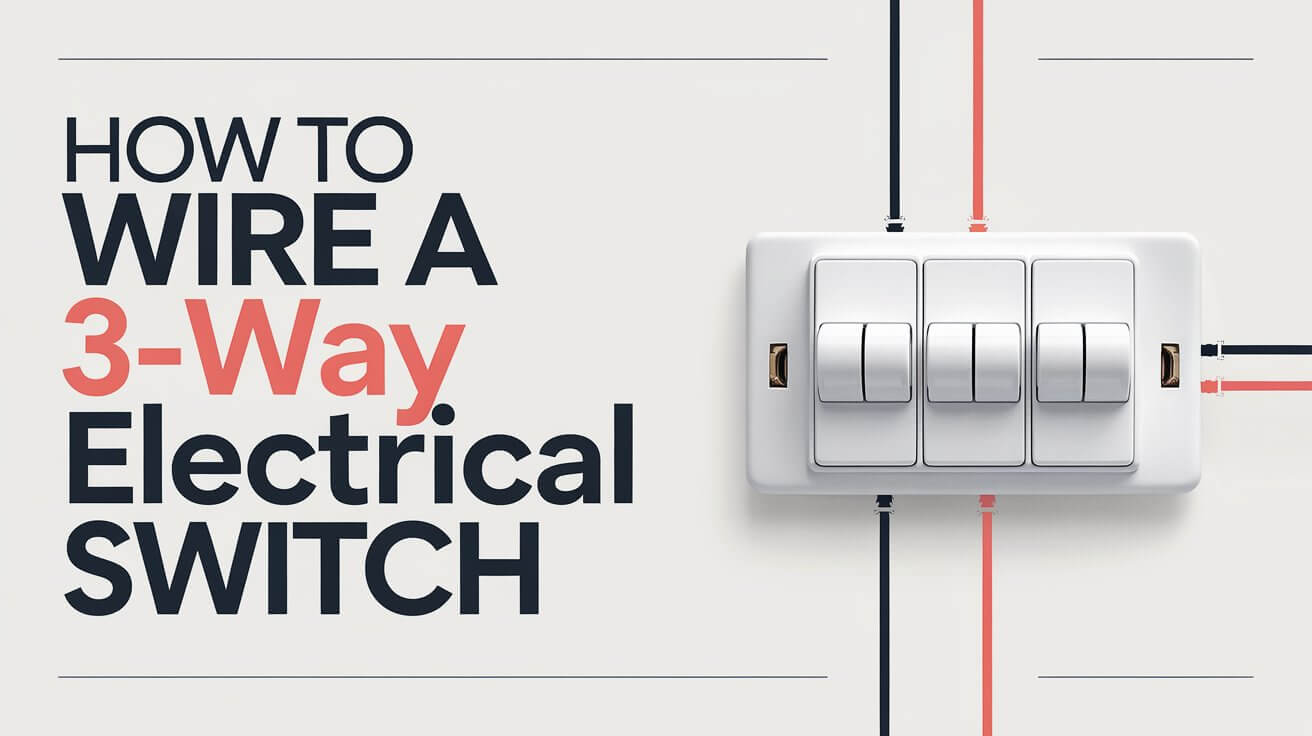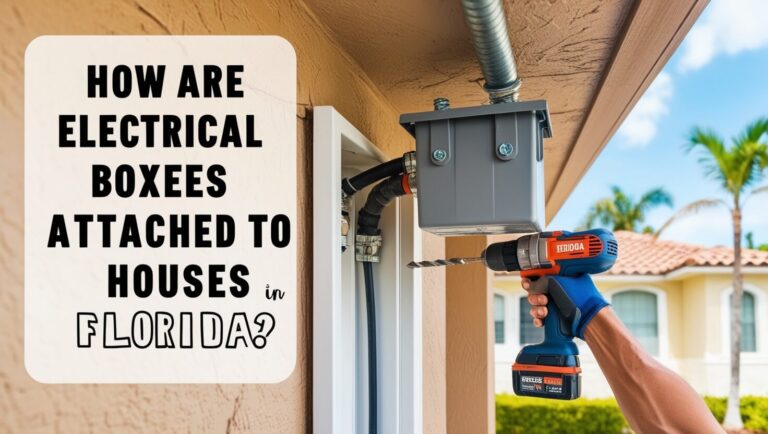How to Wire a 3-Way Electrical Switch: A Step-by-Step Guide

Wiring a 3-way electrical switch can enhance the functionality of your lighting, allowing you to control a single fixture from multiple locations. This setup is commonly used in hallways, staircases, and large rooms with more than one entry point. While the process may seem complex at first, this guide will simplify it into manageable steps. You’ll learn everything from the tools you need to the exact wiring configurations, making this task achievable even for beginners.
What Is a 3-Way Electrical Switch?
A 3-way electrical switch is designed to control a light fixture or group of fixtures from two different locations. Unlike a standard single-pole switch, which can only turn the light on or off from one point, a 3-way switch allows you to do this from two separate points.
Difference Between 3-Way and Single-Pole Switches
- Single-Pole Switch: Controls one fixture from a single location.
- 3-Way Switch: Controls the same fixture from two different locations.
Understanding this distinction is essential, as it lays the groundwork for how to wire these switches correctly.
Common Applications
3-way switches are often used in:
- Hallways
- Staircases
- Large rooms with multiple entrances
Materials and Tools Required
Before you begin wiring, gather the necessary materials and tools. Having everything on hand will streamline the process.
Tools Needed
- Wire Stripper: To remove insulation from wires.
- Screwdrivers: Flathead and Phillips for different types of screws.
- Voltage Tester: To ensure the circuit is not live.
- Electrical Tape: For securing connections.
- Pliers: For bending and twisting wires【10】.
Materials
- Two 3-Way Switches: Ensure they are compatible with your electrical system.
- 14/3 or 12/3 Gauge Cable: Use 14-gauge for 15-amp circuits and 12-gauge for 20-amp circuits.
- Wire Connectors: To connect multiple wires together.
- Light Fixture: The light you will control with the switches【12】【11】.
Safety Precautions
Safety is paramount when working with electricity. Always prioritize your well-being.
Turning Off the Power
- Locate the circuit breaker panel.
- Turn off the power to the circuit you will be working on.
- Use a voltage tester to confirm that there is no electrical current in the wires.
General Safety Tips
- Wear insulated gloves and safety glasses.
- Always double-check that the power is off before starting work.
- Follow local building codes and regulations to ensure compliance【9】.
Wiring Configurations for 3-Way Switches
There are two common configurations for wiring a 3-way switch, depending on where the power source is located.
Option 1: Power at the First Switch
In this configuration, the power comes into the first switch, then travels to the second switch, and finally connects to the light fixture. This is a straightforward setup.
Option 2: Power at the Light Fixture
Here, the power source connects directly to the light fixture. From there, wires are routed to each of the 3-way switches. This method can be slightly more complicated due to the need to manage neutral wires【12】【10】.
Key Components
- Common Terminal: Connects to the power source or light fixture.
- Traveler Terminals: Two terminals on each switch for traveler wires, which allow the switch to communicate with one another【11】.
Step-by-Step Wiring Process for a 3-Way Switch
Now that you’re equipped with the right tools and knowledge, let’s walk through the step-by-step process to wire a 3-way switch.
Step 1 – Turning Off the Power
- Locate the Breaker Panel: Identify the correct breaker for your circuit and turn it off.
- Confirm with a Voltage Tester: Check both switches to ensure there’s no live current before proceeding【12】.
Step 2 – Removing the Old Switches
- Take Off the Switch Plates: Use a screwdriver to remove the faceplate.
- Unscrew the Old Switches: Gently pull out the switches from the electrical boxes. Make a note of how the wires are connected, or take a photo for reference【11】.
Step 3 – Identifying and Labeling Wires
- Identify the Wires: In most 3-way switch setups, you’ll encounter:
- Common Wire: Usually black.
- Traveler Wires: Typically red and black.
- Ground Wire: Green【12】.
- Label Wires: If you’re using a white wire as a hot wire, mark it with black tape to avoid confusion later【10】.
Step 4 – Connecting the New Switches
First Switch
- Connect the Common Wire: Attach it to the black screw.
- Attach the Traveler Wires: Connect these to the brass screws.
- Ground Wire: Secure it to the green terminal【11】.
Second Switch
- Repeat the Connections: Follow the same steps as the first switch. The common wire should lead to the light fixture, while the traveler wires connect between the two switches【12】【10】.
Step 5 – Reassemble and Test the Switches
- Push Switches Back: Carefully place the switches back into their electrical boxes.
- Secure the Wall Plates: Screw on the wall plates, making sure everything is aligned correctly.
- Turn the Power Back On: Head to the circuit breaker and restore power. Test the switches to ensure they work as expected【9】.
Troubleshooting Common Wiring Issues
Sometimes, things don’t go as planned. If you encounter issues after installation, here are some common problems and solutions.
Switch Works Inconsistently or Not at All
- Check Connections: Loose or miswired connections can disrupt the circuit. Double-check your work【9】.
Light Only Works from One Switch
- Incorrect Common Wire Placement: Ensure the common wire is connected correctly at both switches【10】【11】.
Flickering or Buzzing Sound
- Loose Wire: A loose connection may cause flickering or buzzing. Recheck all connections【11】.
Adding a Dimmer to a 3-Way Switch Setup
If you want to add a dimmer to your 3-way switch configuration, you can do so by following specific guidelines. A dimmer switch allows you to adjust the light level, enhancing the ambiance in any room.
When to Use a Dimmer
Consider using a dimmer in spaces that require variable lighting, such as living rooms, dining areas, or bedrooms.
Installation Considerations
- Ensure Compatibility: Make sure the dimmer is compatible with 3-way switches.
- Replacing One Switch: Typically, you replace one of the 3-way switches with a dimmer while keeping the other switch as is【10】【9】.
Advanced Wiring Scenarios
If you’re feeling confident, you may want to explore more advanced configurations for your 3-way switches.
Multiple Switches Controlling a Single Light
In scenarios where you need to control one fixture from three or more locations, you can add additional 4-way switches. These switches are installed in between two 3-way switches and allow for additional control points.
Controlling Multiple Fixtures with a Single 3-Way Setup
If you have more than one light fixture you wish to control from two locations, you’ll need to adjust the wiring. Connect the additional fixtures in parallel to the same circuit, ensuring all connections are secure【12】.
Important Wiring Tips and Best Practices
To ensure your 3-way switch installation is successful, consider the following tips:
Follow Local Electrical Codes
Always check your local electrical codes to ensure compliance. These codes are in place for your safety and the safety of your home.
Use Wire Connectors Properly
Wire connectors should be tight and secure. Loose connections can lead to arcing, which is a fire hazard.
Keep Wires Organized
When wiring, keep your wires neatly organized in the switch boxes. Avoid tangling, which can make troubleshooting more difficult later【10】【11】.
Frequently Asked Questions (FAQs)
Can I Use a 3-Way Switch as a Regular Switch?
Yes, a 3-way switch can function as a regular switch, but it must be wired correctly to use only two terminals.
What Happens If I Mix Up the Traveler Wires?
Mixing up traveler wires can cause the light to function incorrectly, such as only working from one switch. Proper labeling and attention to detail during installation can prevent this issue.
How Do I Reset a Tripped Breaker After Wiring the Switch?
After wiring, if the breaker trips, check for any short circuits. Ensure all wires are correctly connected, then reset the breaker by flipping it back to the “On” position【11】【12】.
Conclusion
Wiring a 3-way electrical switch may seem intimidating, but with the right tools and guidance, it can be a manageable project. This configuration allows for greater control over your lighting and can enhance the functionality of your home. By following the steps outlined in this guide and adhering to safety precautions, you can successfully install 3-way switches in your home. Whether you’re replacing old switches or adding new ones, this knowledge will empower you to tackle future electrical projects confidently.


